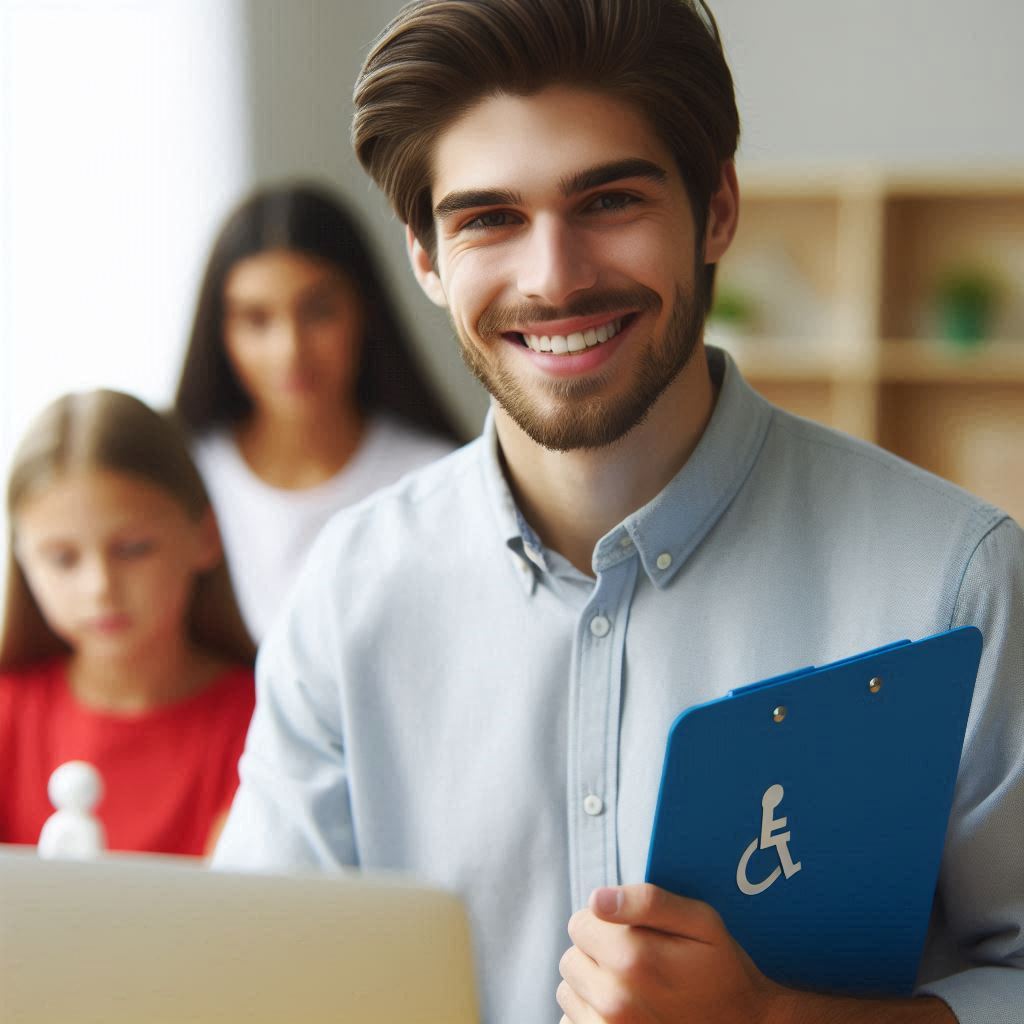Introduction
Technology tools play a crucial role in special education classrooms. They offer tailored support to meet the diverse needs of students with special requirements.
Utilizing these tools enhances the learning experience and helps overcome various challenges faced by these students.
Incorporating technology in special education settings is essential for several reasons.
It provides personalized learning opportunities, accommodating different learning styles and paces.
Assistive technology tools can adapt to individual needs, offering solutions that traditional teaching methods might not.
This adaptability makes learning more accessible and engaging for students with disabilities.
The benefits of technology in special education are significant. Interactive software and apps help students develop essential skills at their own pace.
Tools like speech-to-text programs assist students with communication difficulties, while visual aids and multimedia enhance understanding of complex concepts.
Technology also supports teachers by streamlining lesson planning and providing valuable data on student progress.
Overall, technology tools in special education classrooms are transformative. They create inclusive environments where all students have the chance to succeed.
By integrating these tools, educators can provide a more equitable and effective learning experience for every student, regardless of their unique needs.
Assistive Technology Devices
What assistive technology devices are and how they help students with special needs
Assistive technology devices are tools that help students with special needs to improve their learning and independence.
These devices can range from simple tools to complex technologies, depending on the student’s needs.
Examples of assistive technology devices
Examples of assistive technology devices include communication apps, switches, and sensory tools.
Communication apps help students who have difficulty speaking to communicate effectively.
Switches can assist students with physical disabilities in controlling electronic devices.
Sensory tools can aid students with sensory processing issues in managing sensory input.
Impact of assistive technology on student learning and independence
The impact of assistive technology on student learning and independence is significant.
These devices provide students with the support they need to access educational materials and participate in classroom activities.
By using assistive technology, students can engage more fully in their learning process and develop essential skills that will help them succeed academically and socially.
Transform Your Career Today
Unlock a personalized career strategy that drives real results. Get tailored advice and a roadmap designed just for you.
Start NowOverall, assistive technology devices play a crucial role in empowering students with special needs to reach their full potential in the classroom and beyond.
The use of these tools not only enhances learning outcomes but also promotes independence and self-confidence among students with diverse learning needs.
Read: How Educational Consultants Improve Student Outcomes
Educational Apps and Software
Special education classrooms can greatly benefit from the use of educational apps and software.
These tools are designed to cater to different learning needs and disabilities, helping students to improve their skills and knowledge in a fun and interactive way.
Popular Apps for Special Education
- Proloquo2Go: This app is great for students with speech difficulties as it provides customizable communication boards.
- Read2Go: Designed for students with visual impairments, this app offers access to a vast library of accessible books.
- Pictello: Perfect for students with autism, this app allows them to create visual stories to enhance their communication skills.
- ModMath: Ideal for students with dysgraphia, this app helps them solve math problems without the need for handwriting.
Software Programs for Special Education
- Co:Writer Universal: This word prediction software is beneficial for students with writing difficulties or dyslexia.
- Kurzweil 3000: A comprehensive reading and writing tool that supports students with learning disabilities such as dyslexia.
- Boardmaker Online: Used to create visual schedules and communication boards for students with cognitive impairments.
- Dragon NaturallySpeaking: Speech-to-text software that helps students with physical disabilities to overcome writing challenges.
These tools play a crucial role in enhancing student engagement and improving learning outcomes in special education classrooms.
They provide personalized learning experiences, promote independence, and increase access to educational content for students with diverse learning needs.
By incorporating educational apps and software into the curriculum, teachers can create a more inclusive and supportive learning environment where every student can thrive and reach their full potential.
These tools not only assist students in overcoming their challenges but also empower them to become active participants in their learning journey.
Read: Adapting Curriculum for Students with Physical Disabilities
Adaptive Hardware
Adaptive hardware refers to specialized tools and devices designed to assist students with physical disabilities in accessing technology.
These tools cater to the unique needs of each student, providing them with a more inclusive learning experience.
Types of Adaptive Hardware
- Specialized Keyboards: These keyboards are designed with larger keys or alternative layouts to aid students with limited dexterity or visual impairments.
- Mouse Devices: Adaptive mouse devices include trackballs, joysticks, or touchpads that offer alternative ways for students to navigate a computer screen.
- Touchscreens: Touchscreens enable students to interact with technology through physical touch, making it easier for those with motor skill challenges.
Enhancing Accessibility
Adaptive hardware plays a crucial role in making technology more accessible for students with physical disabilities.
By providing tailored solutions, these tools empower students to engage effectively with digital resources and educational materials.
Specialized keyboards, mouse devices, and touchscreens offer students the opportunity to interact with technology in a way that suits their individual needs.
This customization fosters independence and promotes equal access to learning opportunities.
Considering Individual Student Needs
When selecting adaptive hardware for special education classrooms, it is essential to consider the specific requirements of each student.
By assessing their abilities, limitations, and preferences, educators can choose the most suitable tools to support their learning.
Individualized assessment ensures that students receive the appropriate adaptive hardware that aligns with their unique learning styles and physical challenges.
Showcase Your Business Today
Reach thousands of readers actively exploring professional services. Publish your business profile and grow your audience now.
Publish NowThis personalized approach maximizes the effectiveness of technology integration in special education settings.
Read: Using Positive Reinforcement in Special Education

Communication Tools
Speech-to-Text Software
Speech-to-text software is a valuable tool for students with communication disorders such as speech impediments or language delays.
This software allows students to speak into a device, which then converts their spoken words into text on a screen.
By using this technology, students who struggle to communicate verbally can easily convey their thoughts and ideas in written form.
This can immensely improve their ability to participate in classroom discussions and engage with their peers.
Communication Boards
Communication boards are another essential tool for students with communication disorders.
These boards consist of pictures, symbols, or words that students can point to in order to express their needs, desires, or thoughts.
Communication boards are particularly helpful for non-verbal students or those with limited verbal abilities.
By using communication boards, students can effectively communicate with their teachers and classmates, enhancing their overall classroom experience.
Language Development Apps
Language development apps are interactive tools designed to help students improve their speech and language skills.
These apps often include activities and exercises that target specific areas of language development, such as vocabulary building, sentence formation, and pronunciation practice.
By incorporating these apps into their daily learning routine, students can make significant progress in their communication abilities.
Language development apps are particularly beneficial for students who require extra support in developing their language skills.
Supporting Students with Communication Disorders
Communication tools play a crucial role in supporting students with communication disorders and delays.
These tools provide alternative means of communication for students who may face challenges in expressing themselves verbally.
By utilizing communication tools, educators can create an inclusive and supportive learning environment where every student has the opportunity to communicate effectively.
Success Stories
There are numerous success stories of students who have greatly benefited from using communication tools.
For example, a student with autism spectrum disorder was able to express his thoughts and emotions using a communication board, leading to improved social interactions and self-expression.
Another student with a speech disorder made significant progress in his communication skills by regularly using speech-to-text software.
These success stories highlight the transformative impact that communication tools can have on students with communication disorders.
Read: Supporting Students with Emotional and Mental Disabilities
Online Learning Platforms
Advantages of Online Learning Platforms for Students with Special Needs
- Flexibility in learning schedules for students with varying needs
- Access to a wide range of resources and materials tailored to different learning styles
- Opportunities for interactive and engaging learning experiences
- Ability to track progress and provide real-time feedback for better support
Features of Online Platforms Supporting Personalized Learning and Accommodations
- Customizable settings for font size, background color, and audio options
- Individualized learning paths based on students’ unique goals and abilities
- Integration of assistive technologies such as screen readers and speech recognition tools
- Personalized feedback and recommendations for student improvement
Tips for Educators on Integrating Online Learning into Special Education Curriculum
- Provide training and support for students to navigate online platforms effectively
- Collaborate with parents and caregivers to reinforce learning at home
- Utilize data analytics to monitor student progress and adjust interventions accordingly
- Incorporate a blend of online and offline activities to cater to diverse learning needs
Data Collection and Progress Monitoring Tools
Significance of Data Collection and Progress Monitoring
Data collection and progress monitoring are essential components of special education classrooms.
It allows educators to track student performance, identify areas of improvement, and make data-driven instructional decisions.
Progress monitoring helps teachers evaluate the effectiveness of interventions and adjust teaching strategies accordingly.
It provides valuable insights into students’ progress towards their academic goals and objectives.
Tools and Software Programs for Data Tracking
- Google Forms: A versatile tool for creating online surveys and quizzes. Teachers can use it to collect data on student performance, behavior, and progress.
- Excel: A powerful spreadsheet program that allows educators to organize and analyze data effectively. It can be used to track student progress over time.
- ClassDojo: An app that enables teachers to track student behavior and engagement in real-time. It provides valuable insights for behavior management and intervention planning.
- Illuminate Education: A comprehensive data management system that helps educators track student progress, analyze assessment data, and generate reports to inform teaching practices.
Role of Technology in Assessing Student Progress
Technology plays a crucial role in assessing student progress in special education classrooms.
It enables educators to collect data efficiently, analyze trends, and make informed decisions based on individual student needs.
By using data tracking tools and software programs, teachers can monitor student progress in real-time, identify areas of strength and weakness, and adjust instructional strategies accordingly.
This personalized approach to teaching enhances student learning outcomes and promotes academic success.
Conclusion
Technology tools play a crucial role in special education classrooms by providing personalized learning experiences for students with special needs.
These tools offer various benefits such as accessibility, individualized instruction, and improved communication.
It is vital for educators to incorporate technology into their teaching practices to enhance student engagement, motivation, and academic outcomes.
By leveraging innovative technology solutions, teachers can create inclusive learning environments that cater to diverse learning styles and abilities.
Therefore, I encourage educators to explore and implement a wide range of technology tools to support students with special needs effectively.
By embracing technology, teachers can empower students to reach their full potential and achieve academic success despite their challenges.
[E-Books for Sale]
The Big Book of 500 High-Paying Jobs in America: Unlock Your Earning Potential
$19.99 • 500 High-Paying Jobs • 330 pages
Explore 500 high-paying jobs in America and learn how to boost your career, earn more, and achieve success!
See All 500 High-Paying Jobs of this E-Book
1001 Professions Without a Degree: High-Paying American Jobs You Can Start Now
$19.99 • 1001 Professions Without a Degree • 174 pages
Discover 1001 high-paying jobs without a degree! Unlock career tips, skills, and success strategies for just $19.99!




